As Sporting Portugal won the 2018/19 Taça de Portugal title, Bruno Fernandes interviewed his good friend and teammate, Stefan Ristovsk, as a good-natured piece of entertaining content for the Sportingistas. The Macedonian paused his celebration, took the mic and made a half-joking/half-serious appeal to his superstar teammate, saying, “Please stay with us for next season, otherwise we’re f…” well, we’re sure you can guess the rest.
As the two teammates and their nearby colleagues erupted in laughter, the reality is that there was a dark cloud looming over Sporting Portugal. You’ll recall it was that 2018/19 season that Bruno Fernandes surpassed Frank Lampard’s record of 27 goals in a season by a midfielder by collecting 33 across all competitions, a total he’s well-positioned to contest in the current campaign.
With the sale of Fernandes to Manchester United, Sporting some desperate need for goals, which showed in the second half of the 2019/20 season.
The sale of Fernandes was a turning point for the Lisbon-based club. Their first major signing was not a player but, rather, their manager, Rúben Amorim. A former Sporting Portugal academy player, Amorim took the reins at the Estádio José Alvalade. Braga managed to keep him for just 13 games before Sporting plucked him with a €10 million buyout. Note that those were the first 13 games of top-flight football that the 36-year-old had ever managed, yet he showed enough quality to become one of the most expensive manager buyouts in the history of the game.
Fast forward to 2020/21 and the club’s reinvestment of that Fernandes money has them on track to win their first league title in 19 years. At the heart of the run is the league’s leading goalscorer, Pedro Gonçalves, who’s more commonly known as Pote. The 22-year-old attacker is not only Sporting’s top goalscorer with 15, but, at the time of writing, leads the league with five more goals than his nearest competition, Sérgio Oliveira.
This scout report will look at the qualities that have led to him being dubbed “The next Bruno Fernandes.” Through tactical analysis, we’ll see that he does have some qualities in common with his Sporting Portugal predecessor, but, at the same time, they are very distinct players. There’s a little bit of Bernardo Silva in his game as well, which will touch upon right away as we examine his role within Amorim’s tactics.
The nominal right-forward
Within Amorim 3-4-3, Pote will most often line up as the right-forward. However, I suggest that this is a nominal description. Although that’s where he’s placed on the team sheet, his role is much more free and dynamic.
Amorim’s three forwards often play very narrow, stretching from one half space to the other. The two outside midfielders, typically Nuno Mendes and Pedro Porro, are the width providers on the team, so there’s really a need for Pote to drift too far wide.
Scrutinizing his role within the forward line, you’ll often see that he’s paired with two more traditional forwards, or possibly a forward and a more traditional winger. That allows him to play a free role, dropping underneath the forward line to operate as a trequartista.
Much like Manchester City’s Bernardo, Pote’s as a player who enjoys drifting inside from the right side of the pitch as he identifies pockets of space to attack. However, more like Fernandes, he has the knack for turning up in the box in the right space at the right time.
Box presence
As you watch Sporting Portugal play, you get the sense that Pote is more of a #10 then a right forward. He’s not so much the player who’s going to receive the ball high in the wing as the team progresses into the attacking third. Rather, he’ll leave that space for Porro and take his place from half space to half space. The objective here is to get the talented finisher into the box. Outside of 6’2″ Paulinho, Sporting doesn’t have dominant aerial presences within the forward line, so they looked to overload the box, using creative, coordinated runs to create pockets of space for the finish.
With Pote taking up a more central starting point and making transitional runs towards the central channel as the team begins to attack the goal, the 5’8″ leading goalscorer can use his anticipation and positional awareness to attack the box. He’s a very active player with incredible stamina. You can see that his mind is always working, always trying to create pockets of space to attack and the body is willing to exploit those spaces.
Our first image gives an idea of his transitions from a wider area into the central channel. On the home island of Juventus star Cristiano Ronaldo, Sporting had possession in Marítimo’s defensive half of the pitch. You can see the Pote has possession of the ball in the right half space. He releases the pass to Nuno Santos, who then completes the switch of play to the left-winger, Vitorino Antunes. As Sporting completes the switch of play, Pote initiates his run to the top of the box.
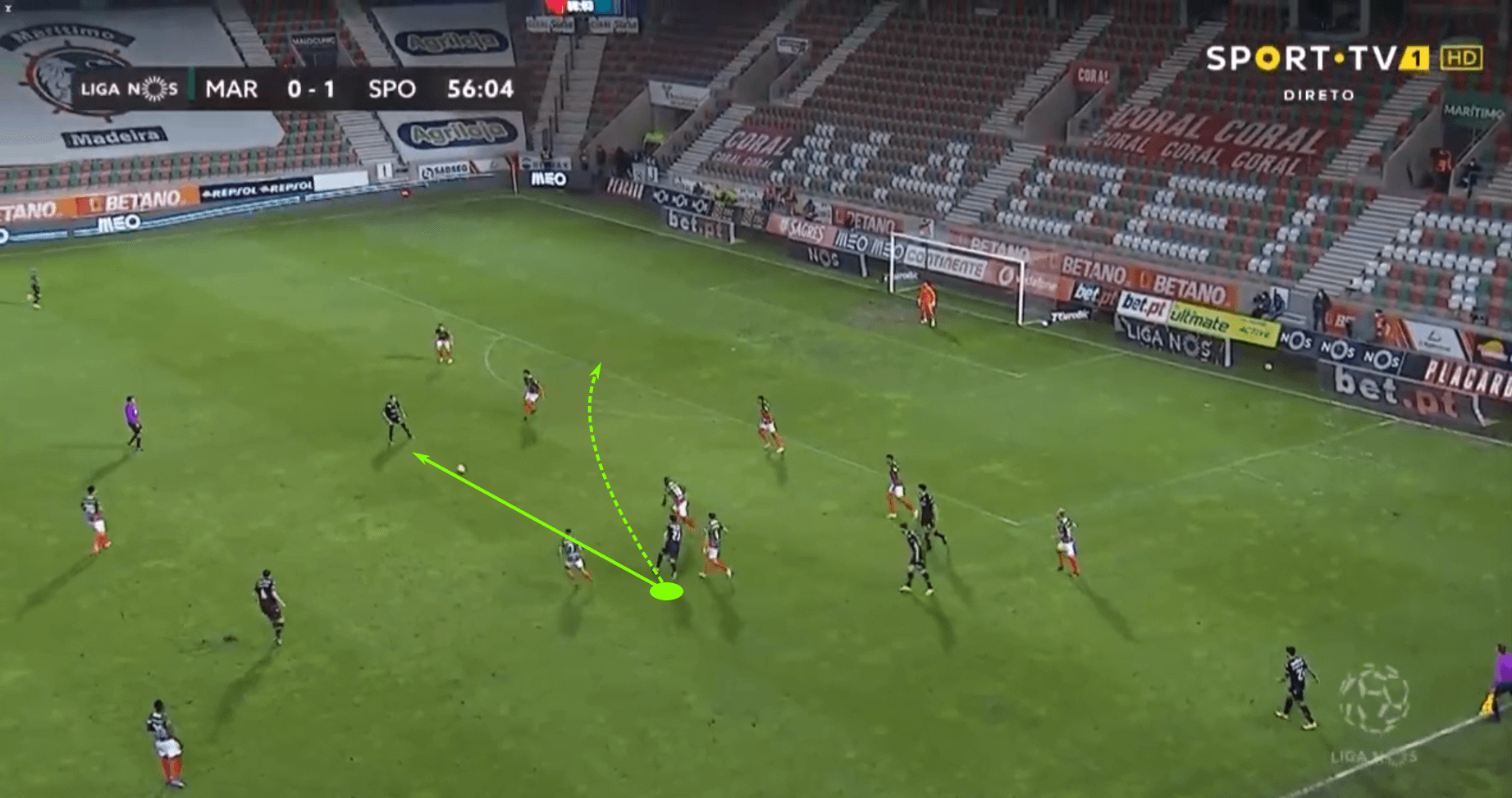
As Sporting crash the box and Marítimo follow, Pote carefully picks out his preferred shooting space, situating himself just behind the penalty spot. A clever first time finish slashes through the defence, leaving the screened goalie helpless.
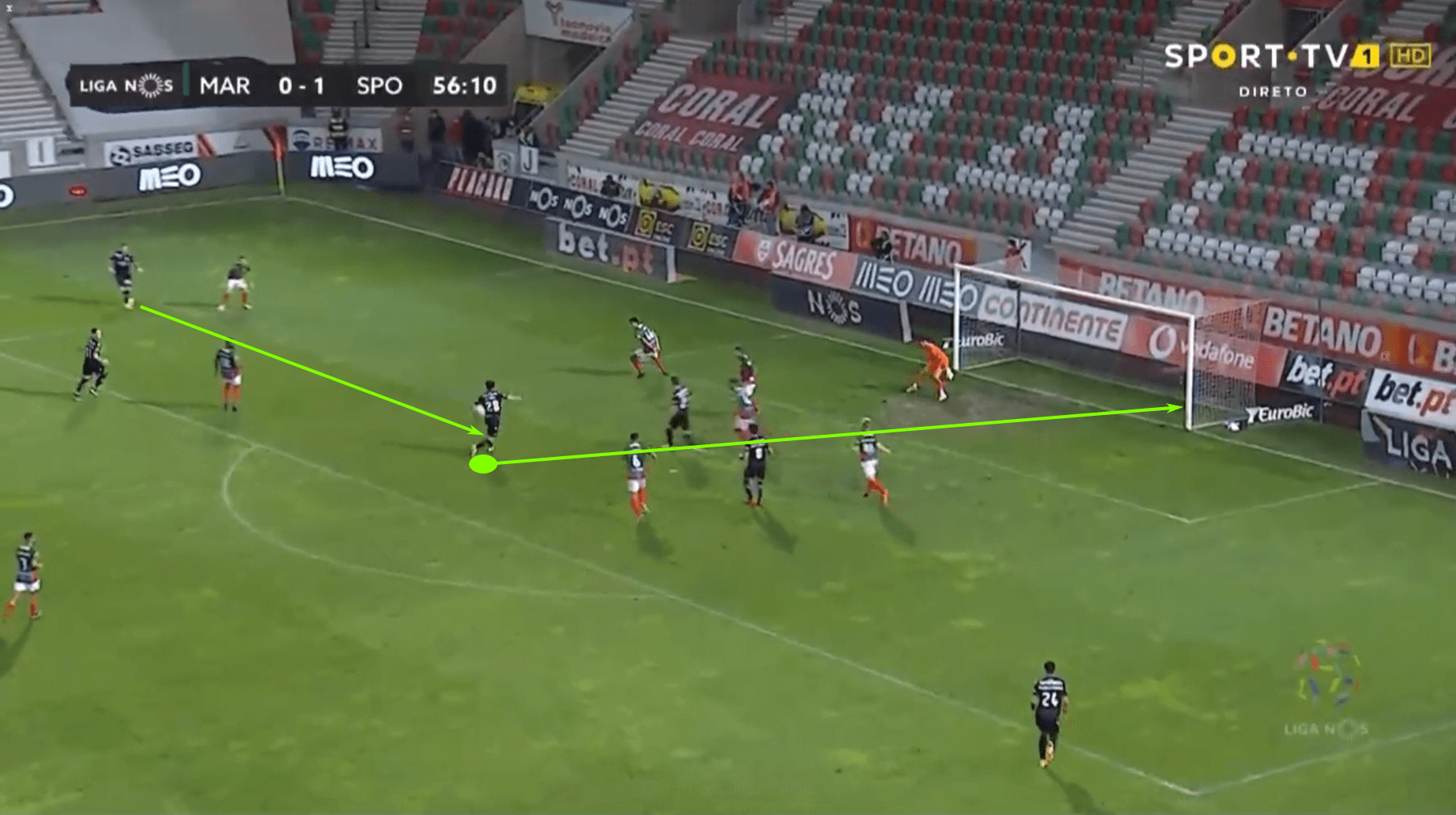
In that sequence, we have an example of Pote engaging in the attack from the right-hand side of the pitch before moving into a more central position. When he is called to participate in positional attacks prior to the move on goal, that’s a pretty standard example.
However, keeping in mind that he does have more of a free, trequartista type role, it’s not uncommon to see him vacate the right side of the pitch, often letting the Manchester City loanee, Pedro Porro, and the Inter Milan loanee, João Mário, to dictate play from the right-hand side. That allows Pote to take up a more advantageous position in the central channel, as we see in this scenario against Rio Ave.

As Sporting completes the long switch of play, Pote Is near the top of the box, almost perfectly situated between the defensive and midfield lines.
The young Ecuadorian, Gonzalo Plata, took a positive first touch and played a perfectly weighted pass into the path of Pote, whose lethal finish gave Sporting a 1-0 lead.
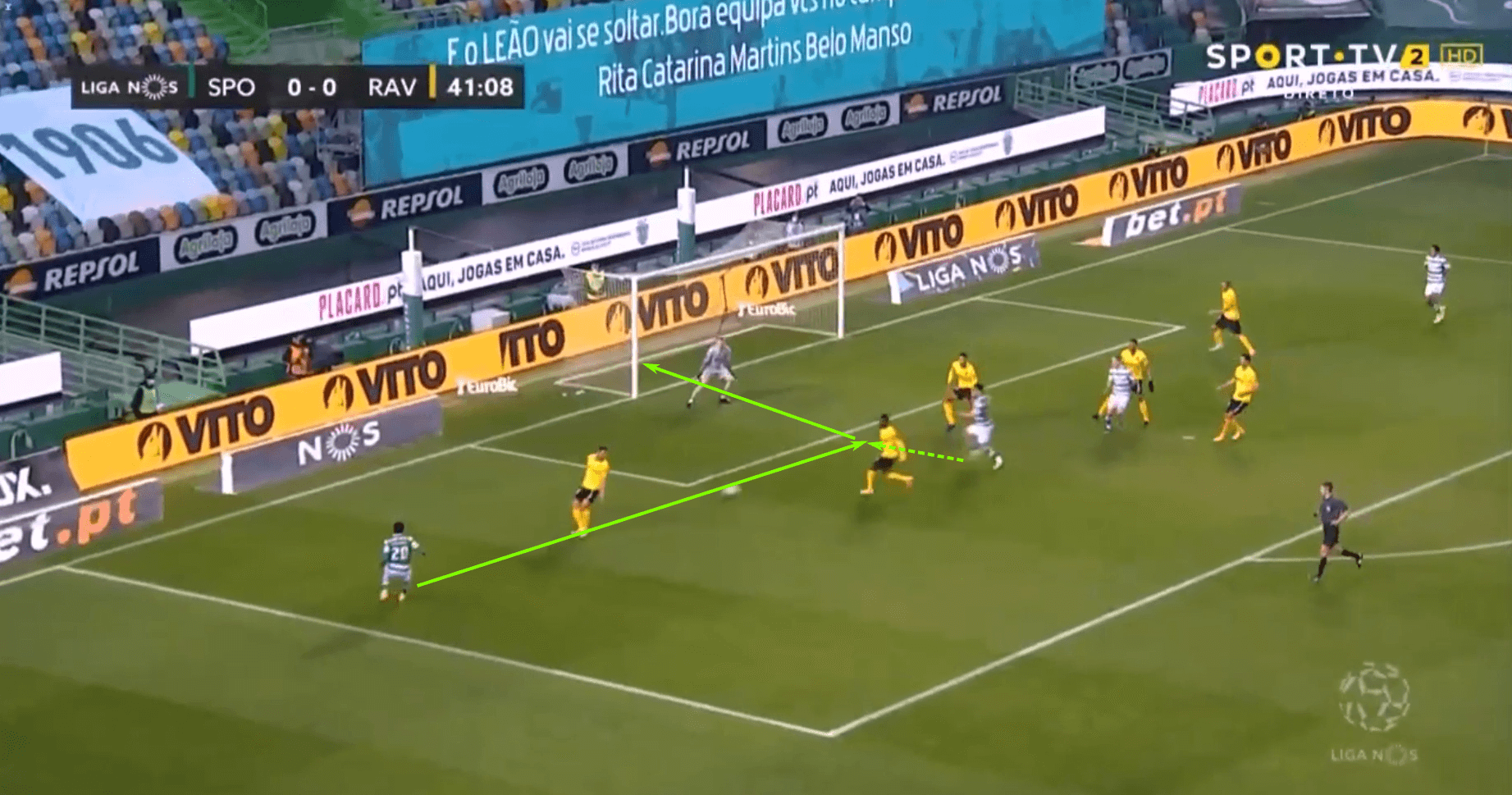
If you’ve gleaned anything from this section of the analysis, it’s that Pote does his best work, the most damage, when he attacks the opposition from the central channel. He’s very crafty in how he claims that space. As the first two examples have shown, he can participate in a wide overload before making a quick burst into the middle of the pitch or he can let his teammates direct the entry into the box while patiently biding his time high in the central channel.
One of the top reasons for his goal-scoring success is the way he’s able to play off of his two forwards. As mentioned, Sportings forwards tend to be a little bit smaller, but incredibly mobile and intellectually active. They’re incredibly aggressive and attacking space behind the lines and moving off of each other. The team has largely found success through the forwards’ ability to manipulate the opposition’s backlines with clever movements.
Our final example from the section is cut from that mould. As Santos makes his run at the back post, he’s beaten his Braga defender, Nuno Sequeira, and managed to nod the ball back to his trailing teammate. Pote is perfectly positioned between the lines and puts in a beautiful finish to give Sporting the winning goal.
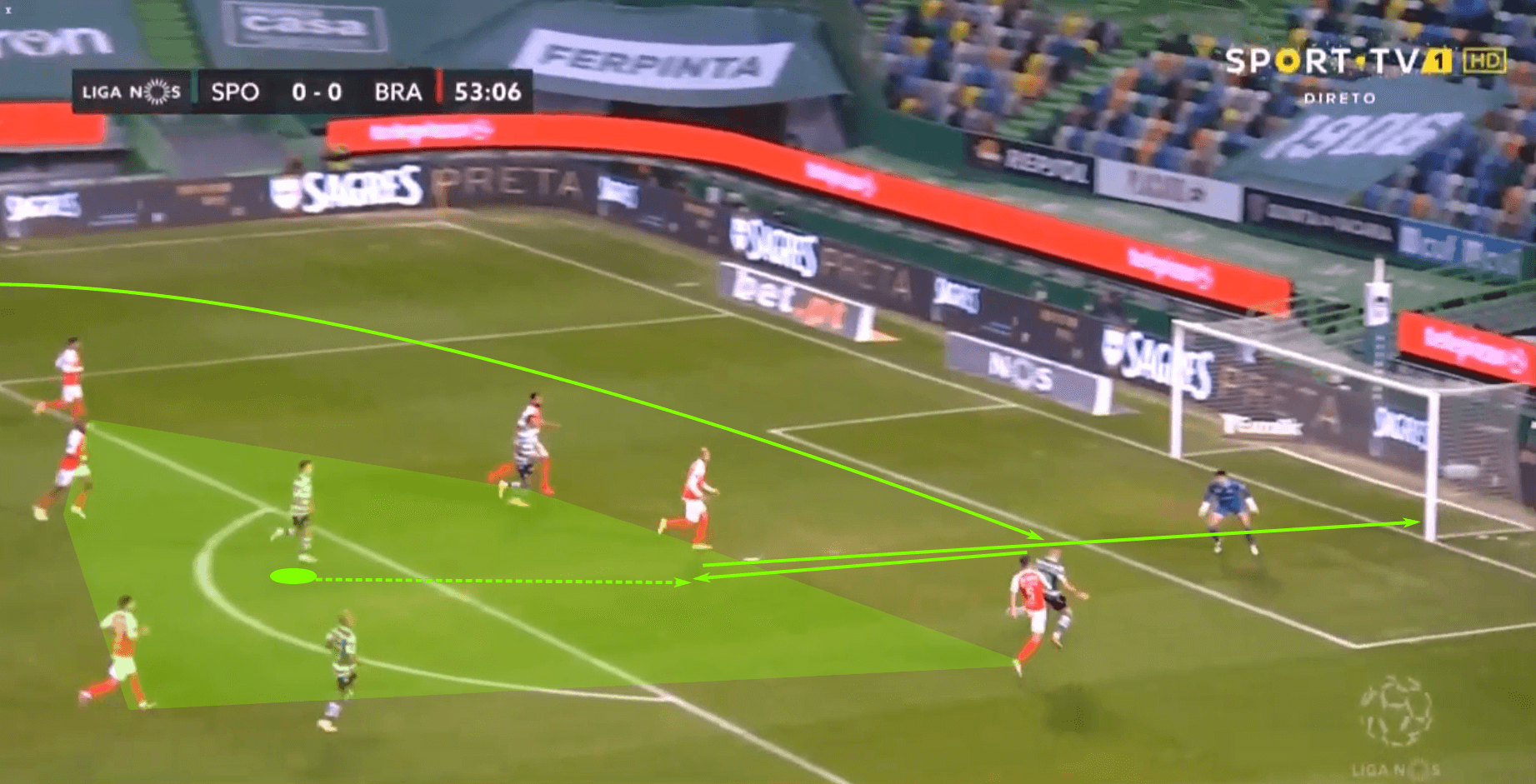
He’s not only a quality finisher but an incredibly intelligent player in the final third. His starting positions are excellent, identifying pockets of space high in the central channel before picking out the runs his teammates need. As you watch his goals, it’s often that he has managed to present teammates with a high percentage pass in a dangerous part of the box.
Spatial occupation and movement
Thus far, you’ve probably gotten this sense that Gonçalves has an exceptional understanding of spatial occupation, as well as the football IQ to use his movements to create additional space. Whether he’s participating in the wide overloads or drifting more centrally, you’ll see first that he’s continuously checking his reference points. The mental image of the pitch is always updating in his mind.
Because he dutifully tracks the movements of his teammates and the opposition, he understands which spaces are currently available and the type of movements he can use to unlock the spaces he really wants to attack. As you watch him play, you can see the small details at work. Watch him use the movements of a teammate to cue his sharp turns up the pitch. Or watch him drift into a pocket of space, positioning himself to engage in an isolated encounter with his nearest mark to create the space he wants to attack.
Going back to the Marítimo game, we had a great example of him starting high up the pitch, then checking into midfield to present himself as an option during the build-out. As Gonçalo Inácio picks his head up and makes eye contact with Pote, you see the sharp turn of field twist attack the space his defender left behind. Inácio does well not to play the initial pass, quickly reading the cue from Pote and playing him over the top.
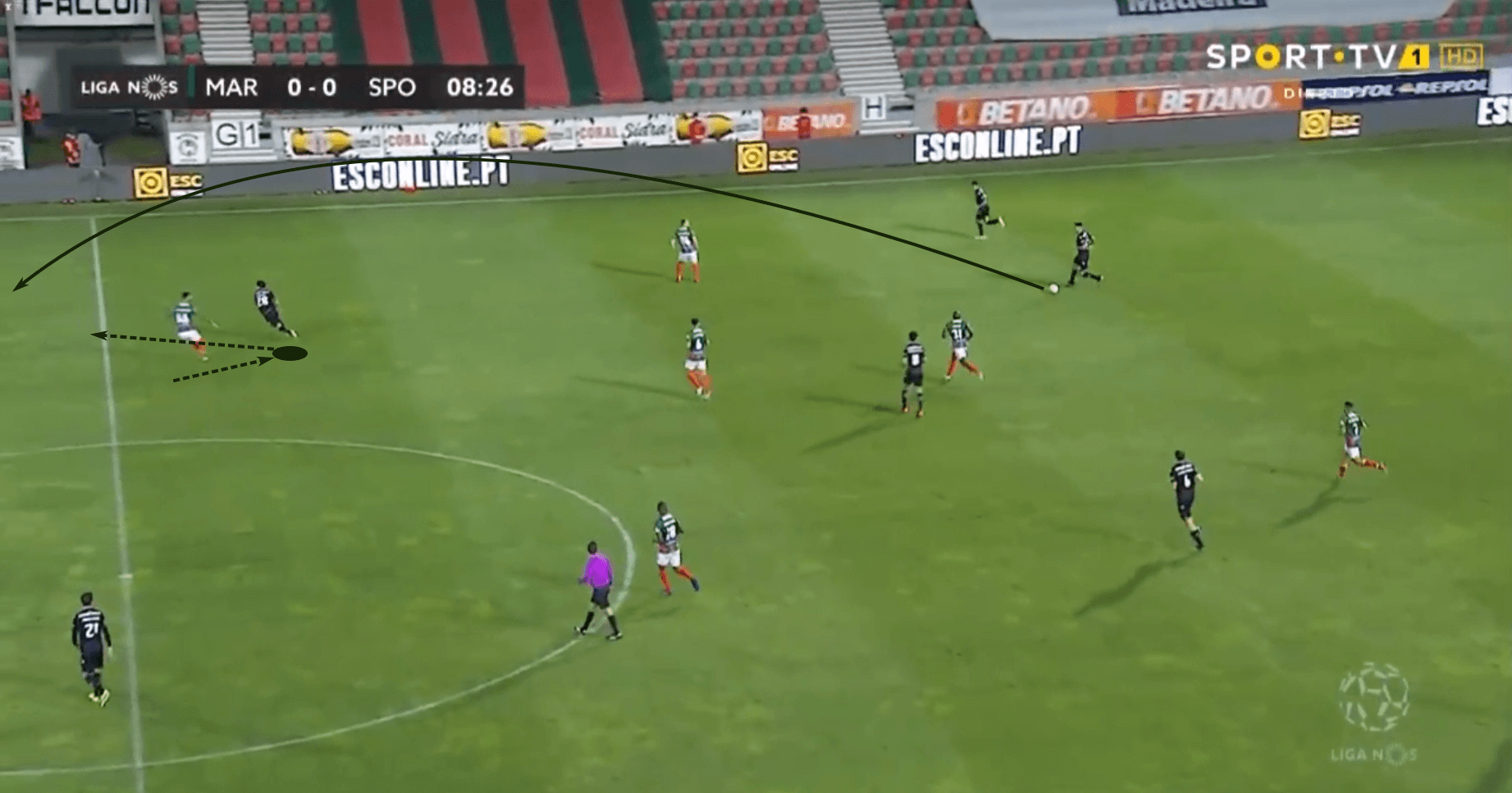
While he’s not blessed with blazing speed, Pote does have excellent quickness and acceleration. His change of pace is exceptional, as is his ability to deceive the opponent, disguising the change in tempo.
In this instance, Pote’s deception and acceleration put him in position to run past the opponent and latch onto the end of the pass. The goalkeeper, Amir Abedzadeh, was caught in no man’s land, allowing Pote to make a nice little move around him before finishing the play with a goal.
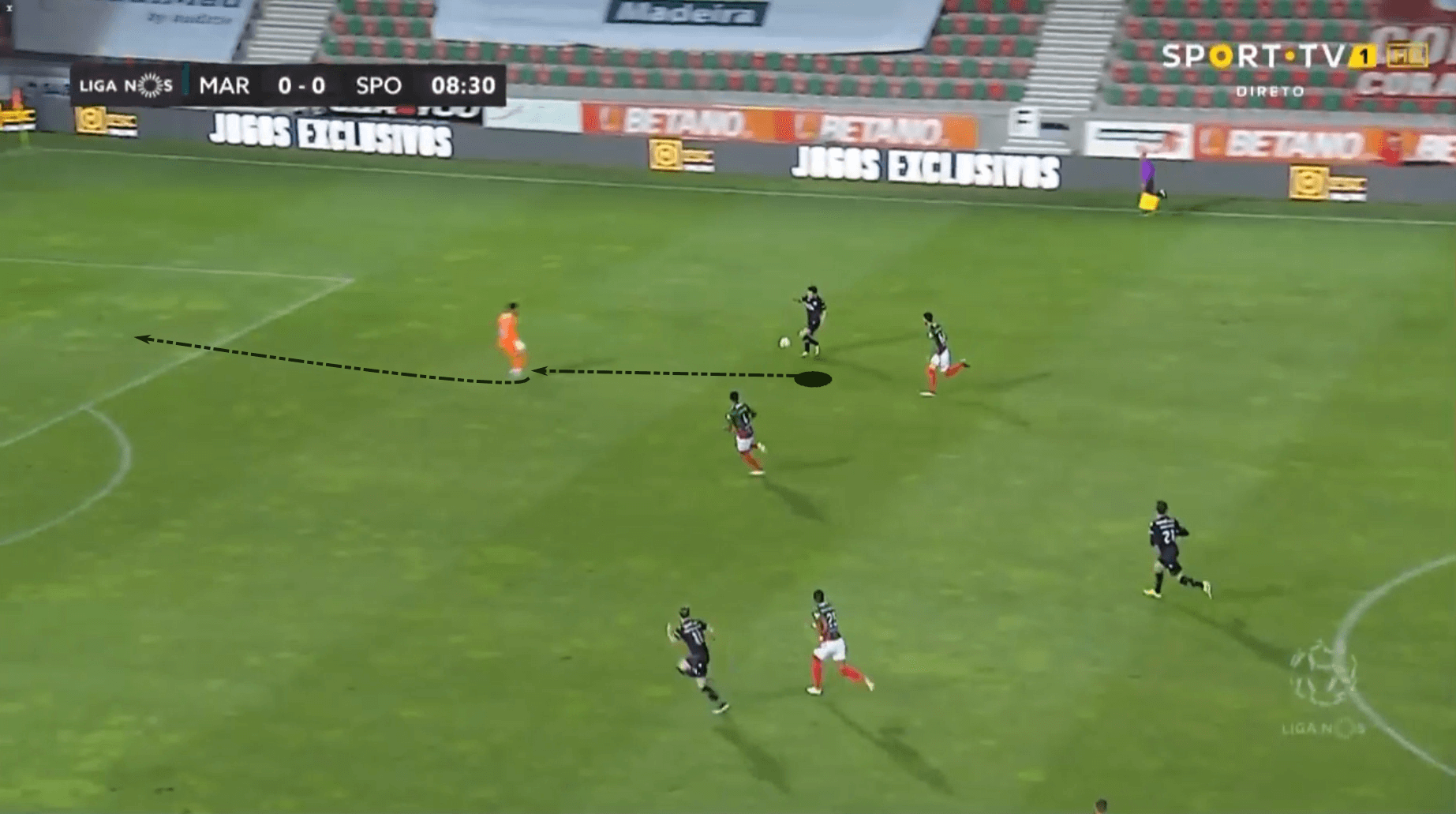
We’ve already noted Pote’s incredible stamina. He just doesn’t stop moving. And it’s not movement simply for the sake of moving. Rather, he’s constantly moving to disrupt the opposition’s defensive shape. If he can’t immediately attack space, which might include situations in which his teammates simply aren’t ready to play forward, Pote goes to work on his nearest marker, attempting to disconnect him from the greater team structure.
Against Porto, Sporting had possession through Mendes in the left-wing. You can see that Sporting are still preparing to attack Porto. They’re not ready to move forward yet, so Pote remains off the back shoulder of his opponent, staying outside of his line of vision and attempting to pull him away from Pepe, the centre-back in cover.
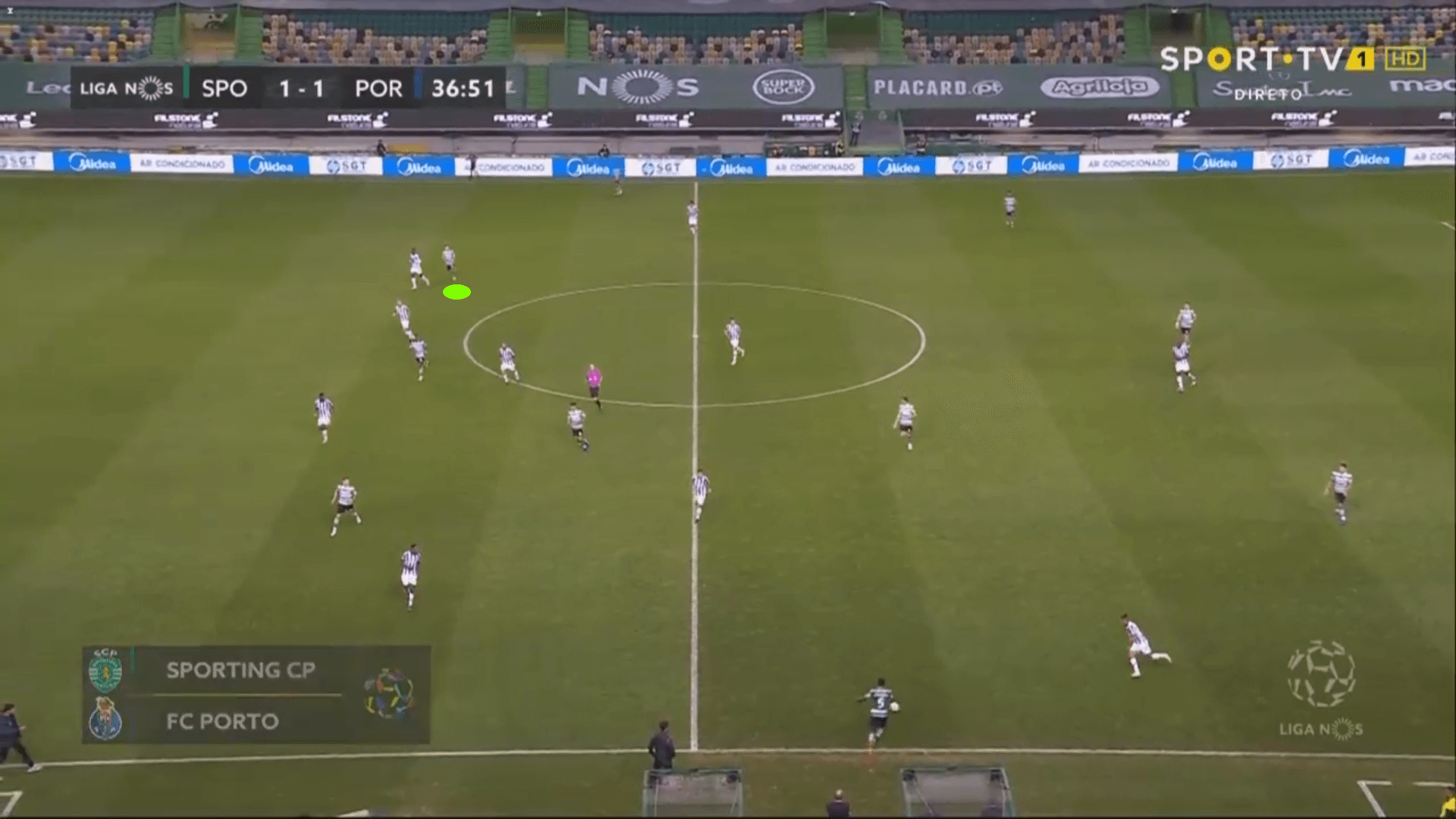
Mendes played into João Palhinha, who scanned his long options and caught sight of Pote’s movement. With a quick horizontal run into a vertical cut of the pitch, Pote was able to latch onto an exceptional pass from Palhinha. Only an excellent recovery from Porto and a nice save from Agustin Marchesin kept the Sporting star off the score sheet.
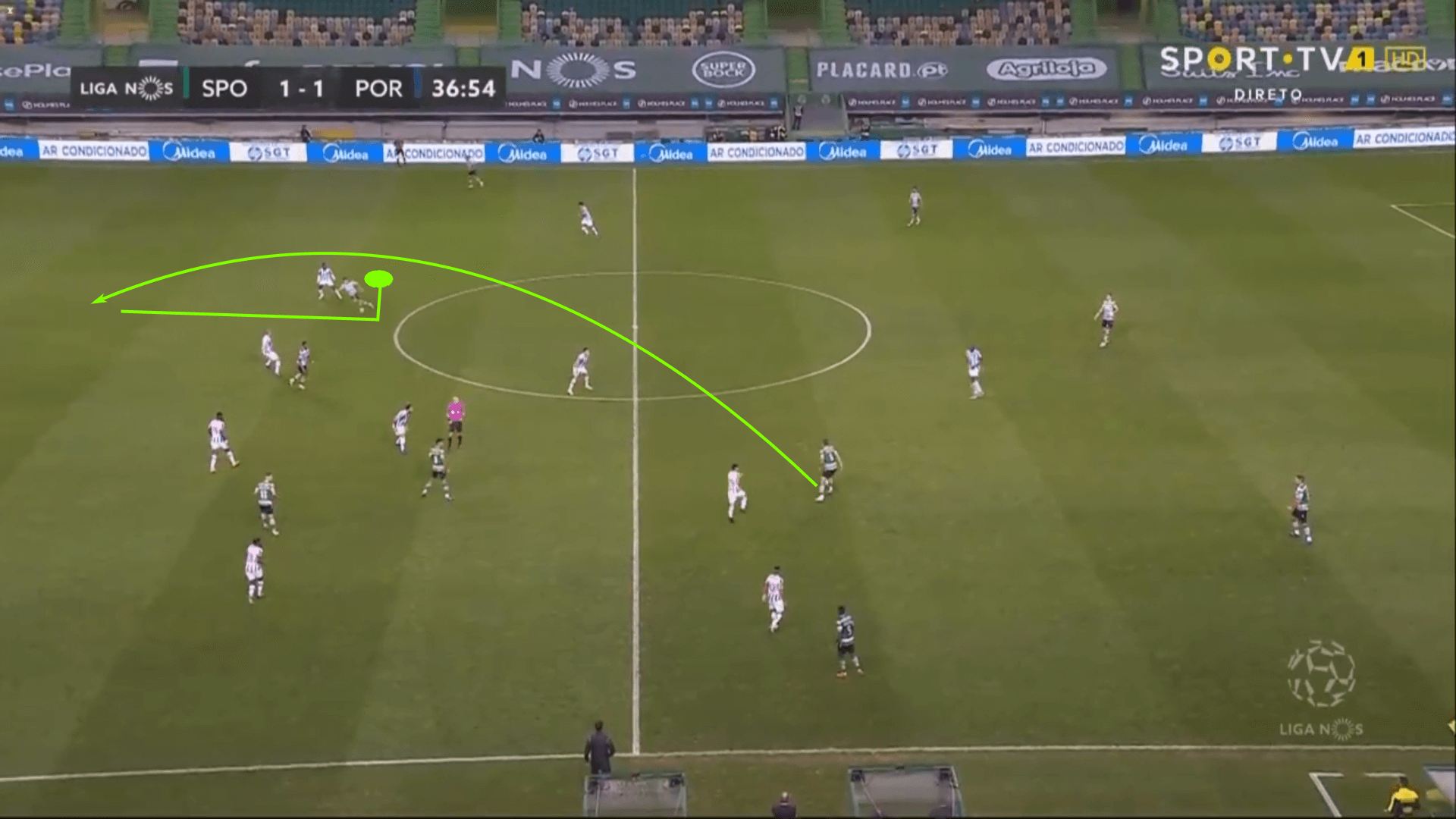
The next example is of a very similar construction. This time, instead of playing off the back shoulder of the opponent, Pote is still in the right half space, but targeting the space between the Porto lines. He’s essentially pulling Pepe centrally to prevent him from providing immediate coverage for Zaidu Sanusi. As Porro wins his 1v1, Pepe left his more central position to transfer into a first defender role. Chancel Mbemba was slow to cover for Pepe and Mateus Uribe couldn’t catch up to Pote.
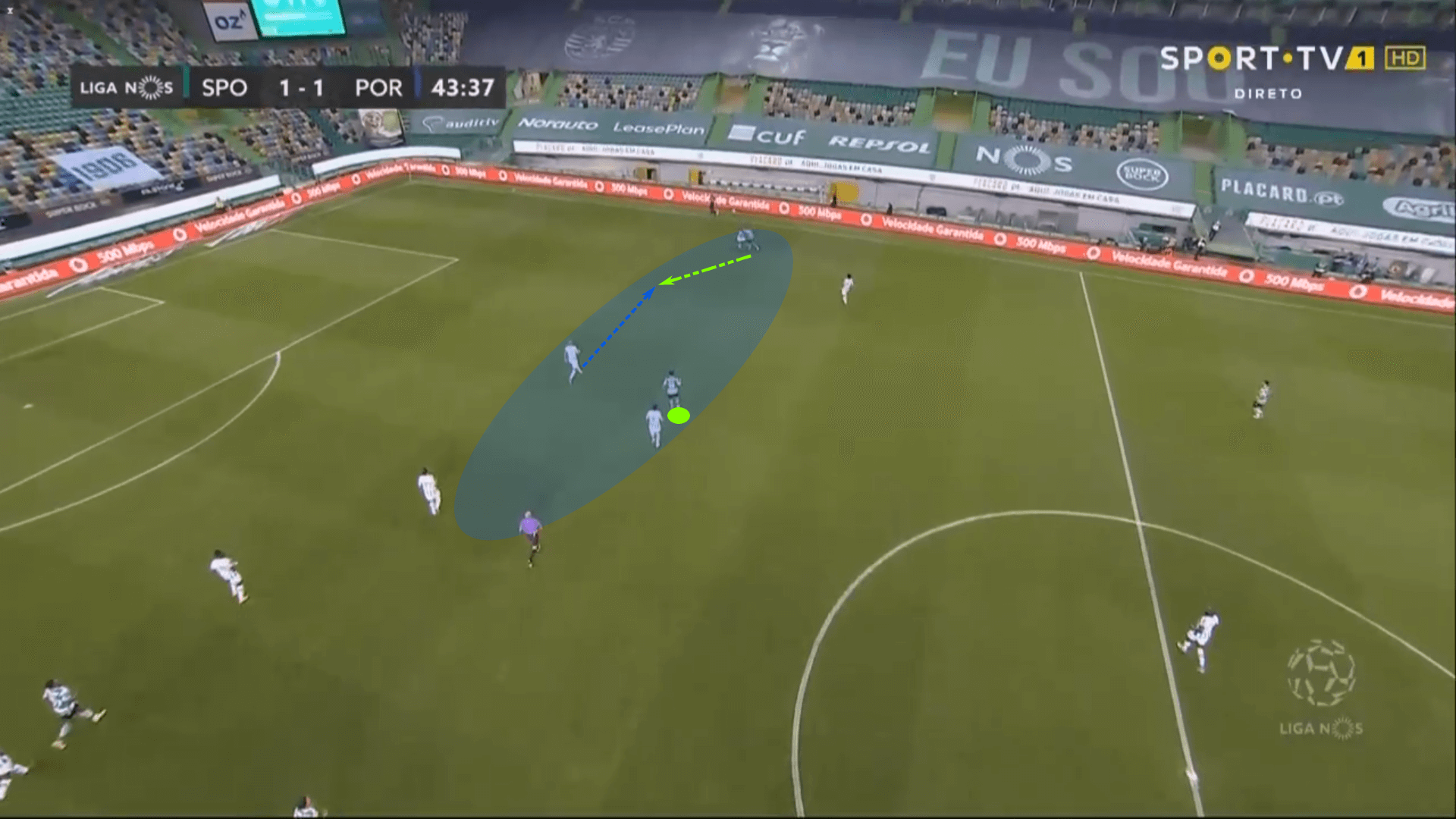
Pote’s disciplined positioning was the foundational part of his involvement, and the quick burst into the box to latch onto Porro’s pass followed.
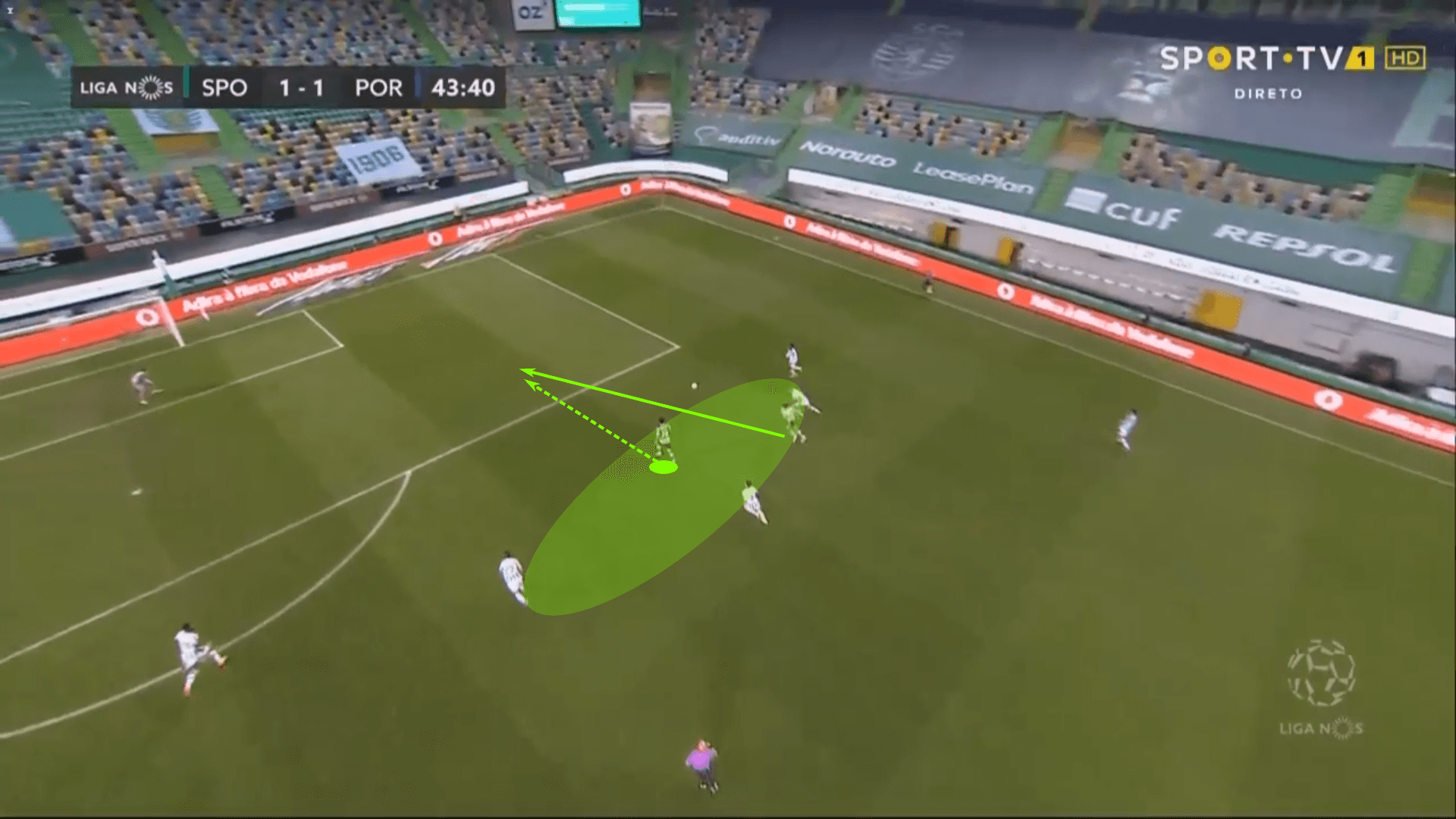
Thus far, we’ve seen that Pote’s spatial orientation and movement to create space, for himself or for teammates, is one of the top strengths in his toolbox. Now, even though he is exceptional in his use of space, he is also a very competent player within tighter confines. In fact, his quickness and ball control make it very difficult for opponents to take the ball off him. He’s consistently able to wiggle out of tight spaces or situations where his body orientation is more advantageous to the defender.
In this section’s final image, Pote started this play by receiving in a tight space, dribbling toward one defender and bracing for the arrival of the second. He essentially funnelled the backtracking defender into the path of the first defender, then used the momentum of the backtracker to cut back to the middle of the pitch and send the long switch.
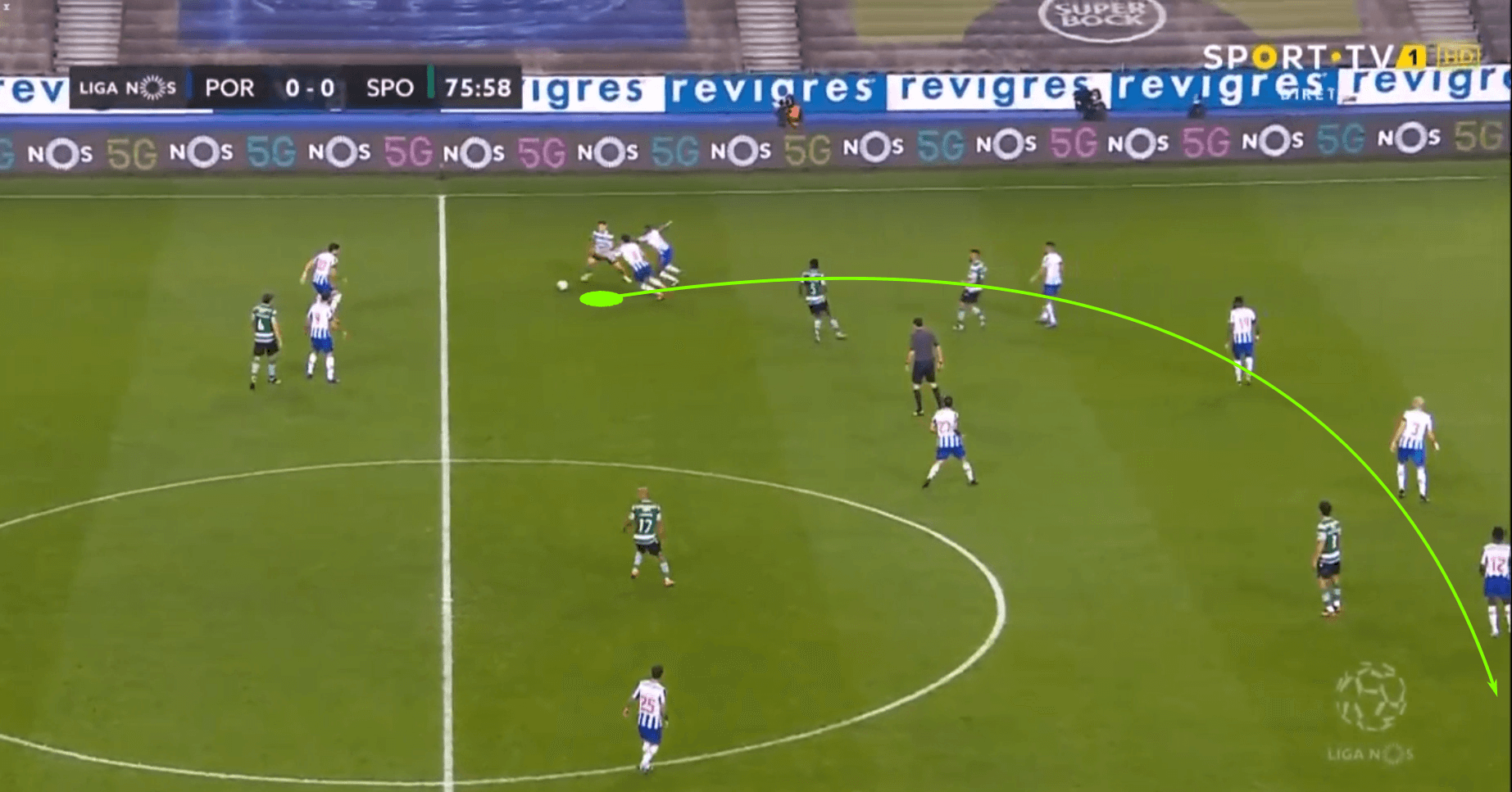
So, whether he’s tracking open spaces in his free role or caught the tighter regions of the pitch to support the build-out or connect the lines, you’ll find he’s very comfortable on the ball and a very press resistant player.
Sporting Portugal and beyond
One of the unfortunate trends for the Portuguese League is that when a team plays exceptionally well, Europe’s elites, or at least teams from the top five leagues with Champions League and Europa League on the docket, come calling. This is especially the case with the younger players developed at the academies. All three of Os Três Grandes have seen their youngsters go on to play prominent roles for Europe’s leading teams over the past couple of decades. This crop of Sporting players will eventually follow suit with Manchester United and Liverpool already rumoured to be interested in the services of Pote.
The allure of Champions League play, as well as Sporting’s success, squad cohesion and the presence of Amorim are likely to keep many of the youngsters in Lisbon for at least the following season. They’re integral parts of an exciting project, so while the big move is certainly on the table for several of these players, there’s certainly enough appeal to stay at Sporting for at least another year.
To get a better sense of Pote’s production in Liga NOS, the player profile below shows how exceptional he has been in and around the box. He rates in the 80th percentile or better in almost all attacking and creativity categories and sends an extraordinary number of passes to the penalty area for 90 minutes.
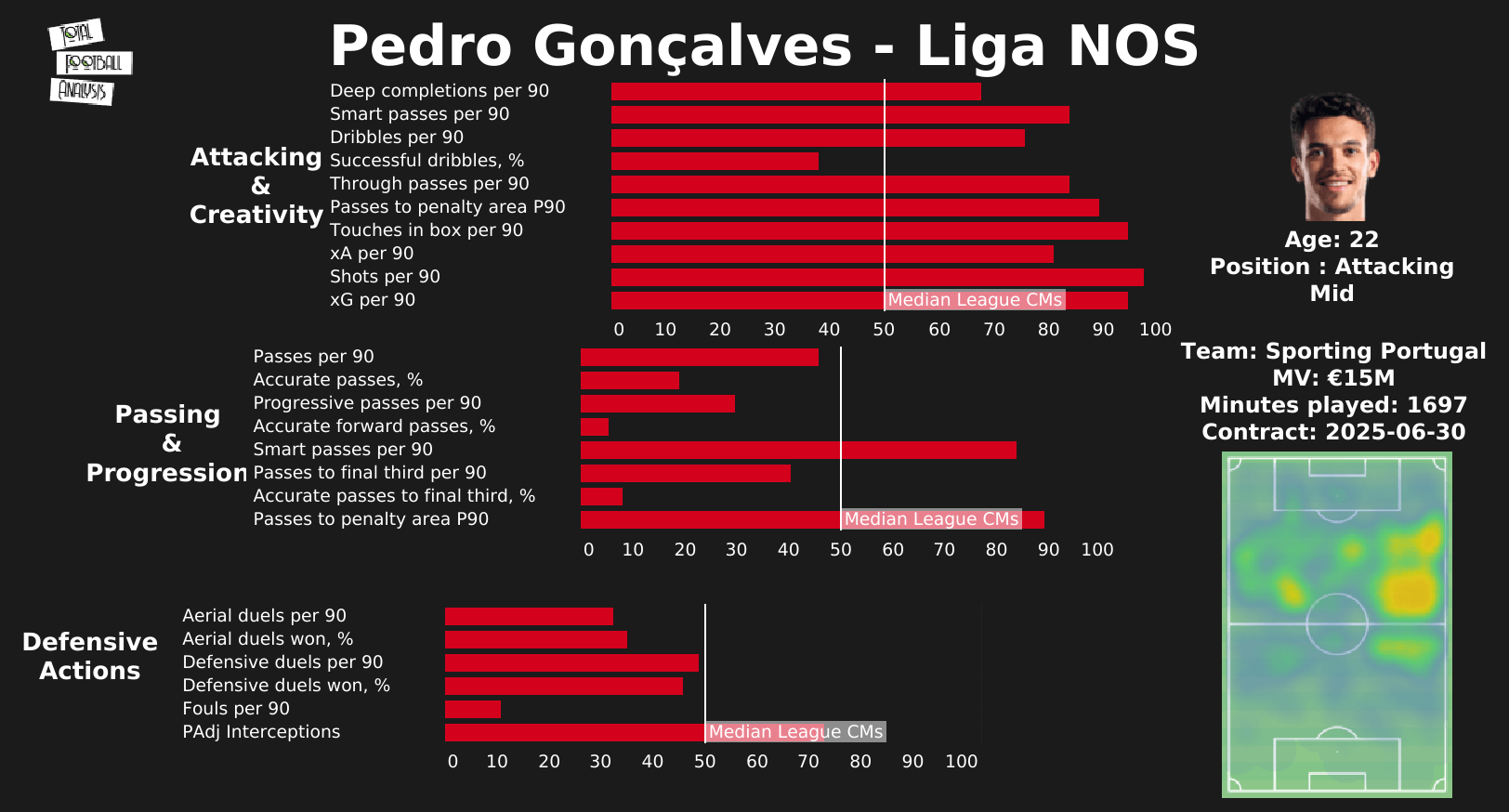
He’s a very committed defender too, rating among the top 30% of the centre attacking midfielders in that category. And yes, I did run his data comparison with the centre attacking mids because that is essentially his function within the team. Again, he’s nominally a right forward. His heat map does show a significant number of touches in the right-wing and half space, but nearly every single one of our in-game images shows him at work in the central channel, and that’s not a selective group either. Watch any match and you’ll see that when Pote is at his dynamic best, it’s because of the way he attacks the central channel.
Putting Pote’s stats in reference to #10s from UEFA’s top five leagues, there’s a little bit of a drop off in several of the attacking and creativity categories, but he still rates in the 70th percentile or better in most. Further, his defensive actions actually improve. He’s a willing defender who reads the game beautifully in the high press. A possession dominant team that prioritizes the high press and counterpressing would do well to have a player of his caliber on their team.
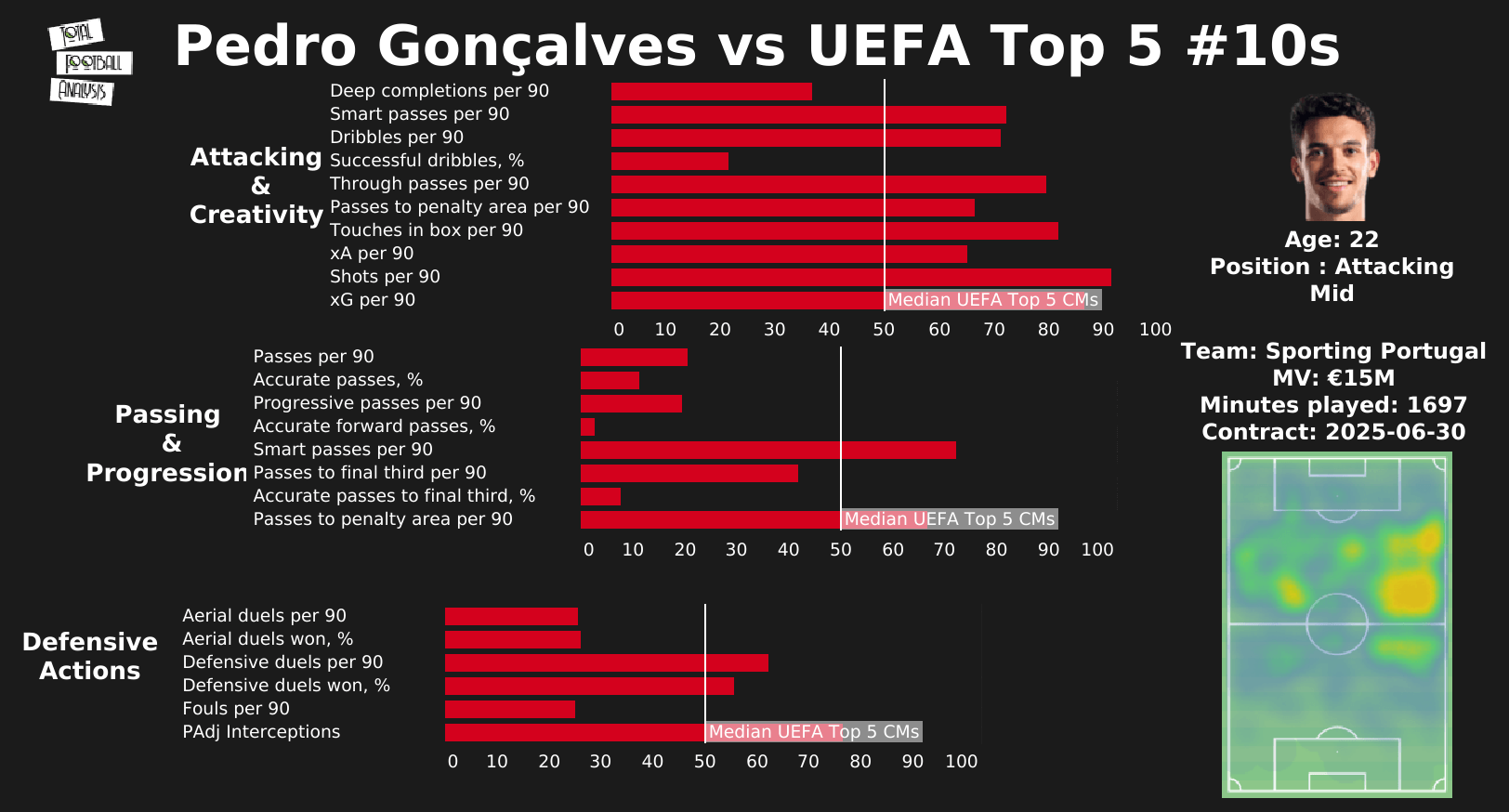
Since he has been dubbed “the next Bruno Fernandes,” I thought it would be fun to run a player profile for Fernandes based on the current year stats.
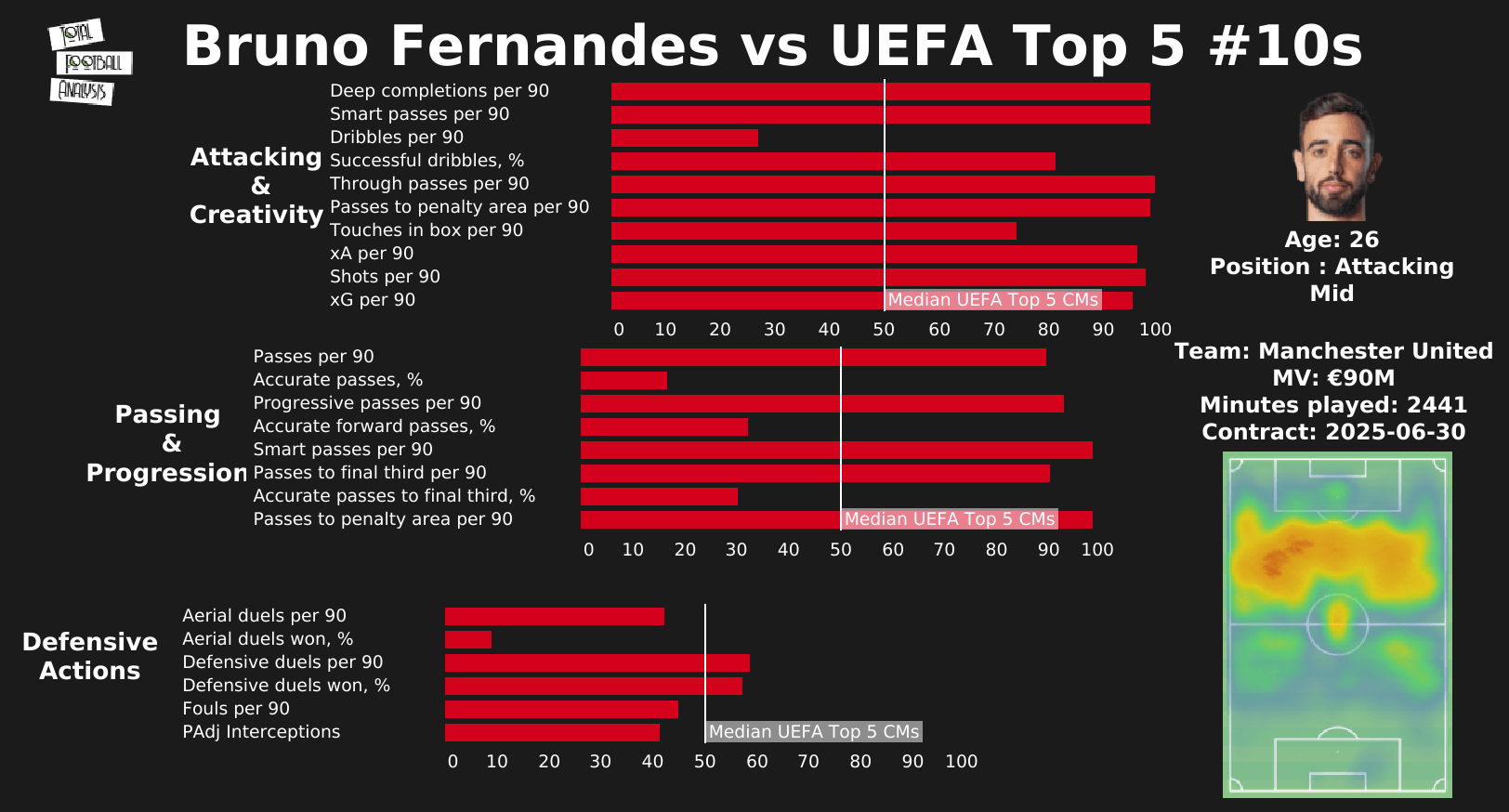
Not only does Bruno register better marks and attacking and creativity, but the real difference between the two players is in their distribution qualities. Fernandes’ usage at Manchester United is near the top of the charts. While his efficiency can improve, it’s the fact that he’s willing to take risks and has the quality to complete the low-risk/high-reward passes that make him so valuable. He might only complete six out of 10 passes into dangerous parts of the pitch, but those six opportunities he’ll create for his teammates far exceed the quality provided by the vast majority of players in a similar role.
Pote doesn’t quite have that knack for picking out and completing those killer passes. In the image from the match against Marítimo, the green line indicates the option he chose, which was an attempted pass to Santos in the left half space. While that is a very dangerous pass if completed, it’s also an extremely low percentage pass.
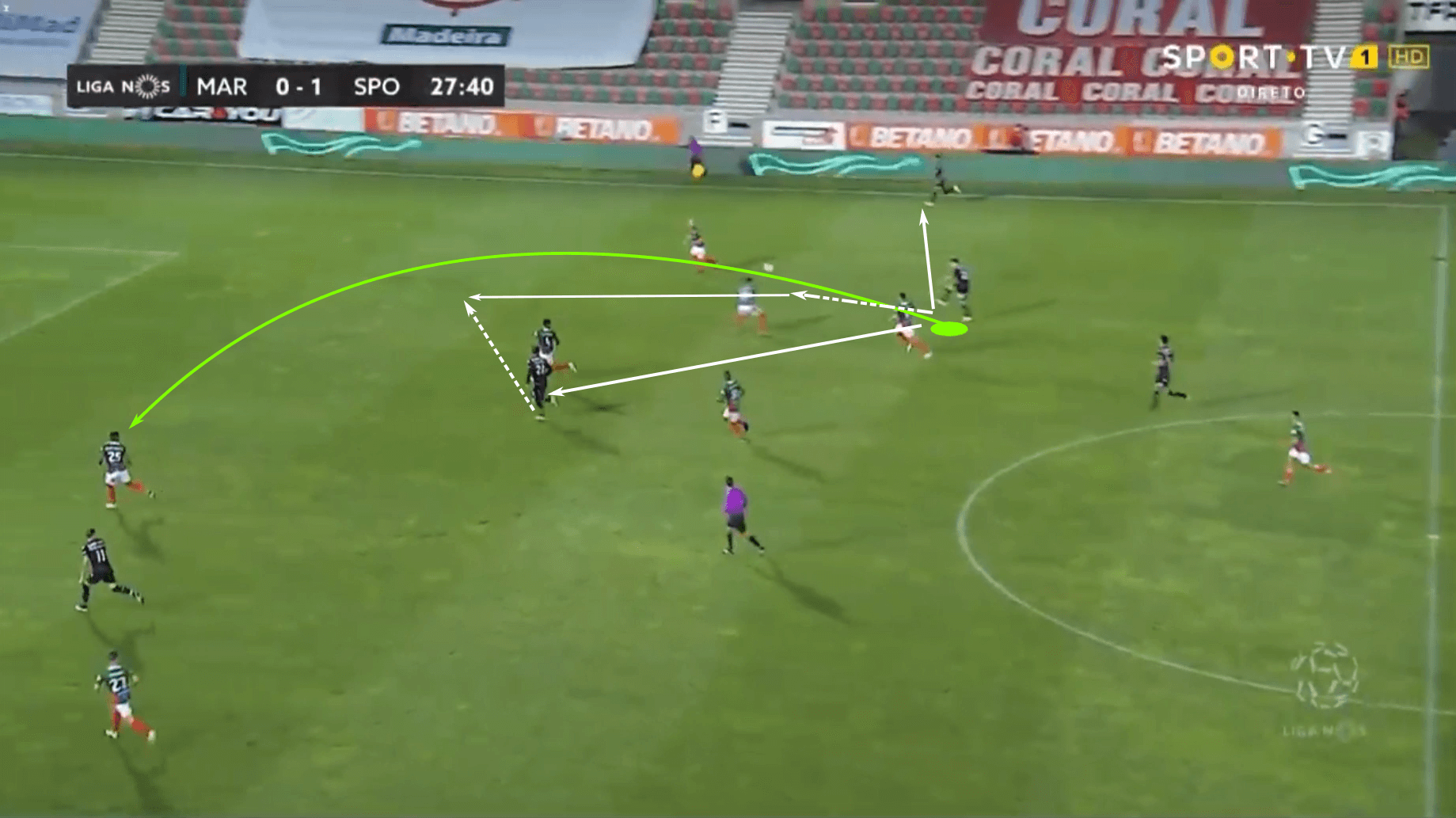
What makes it worse is that he has quality options available to him. A pass into the wings puts Porro in a 1v1 situation with space to run into. There’s a slightly risky pass available to the central channel, but there’s also the option to dribble forward, pin the defender and buy time and space first teammate to attack the right half space before sending a through ball.
Decision making is certainly one area that needs to improve for him to become one of the elite trequartistas in global football, but so does the assessment that goes into the technical action as well. He’s a wonderfully technical player, frequently taking free kicks for the side, but there are times when the technical actions in open play are lacking quality.
Again, that’s not to say the quality isn’t already there. When he does have more time and space to pick out his passes, especially from a more static starting point, he does show his ability to break the opposition.
In our final image, Sporting took a trip to the Açores island of São Miguel to take on Santa Clara. In this image, we see that Pote has found a pocket of space in front of the Santa Clara midfield. From there, he was able to pick out his teammate’s run and beautifully loft it over the backline.
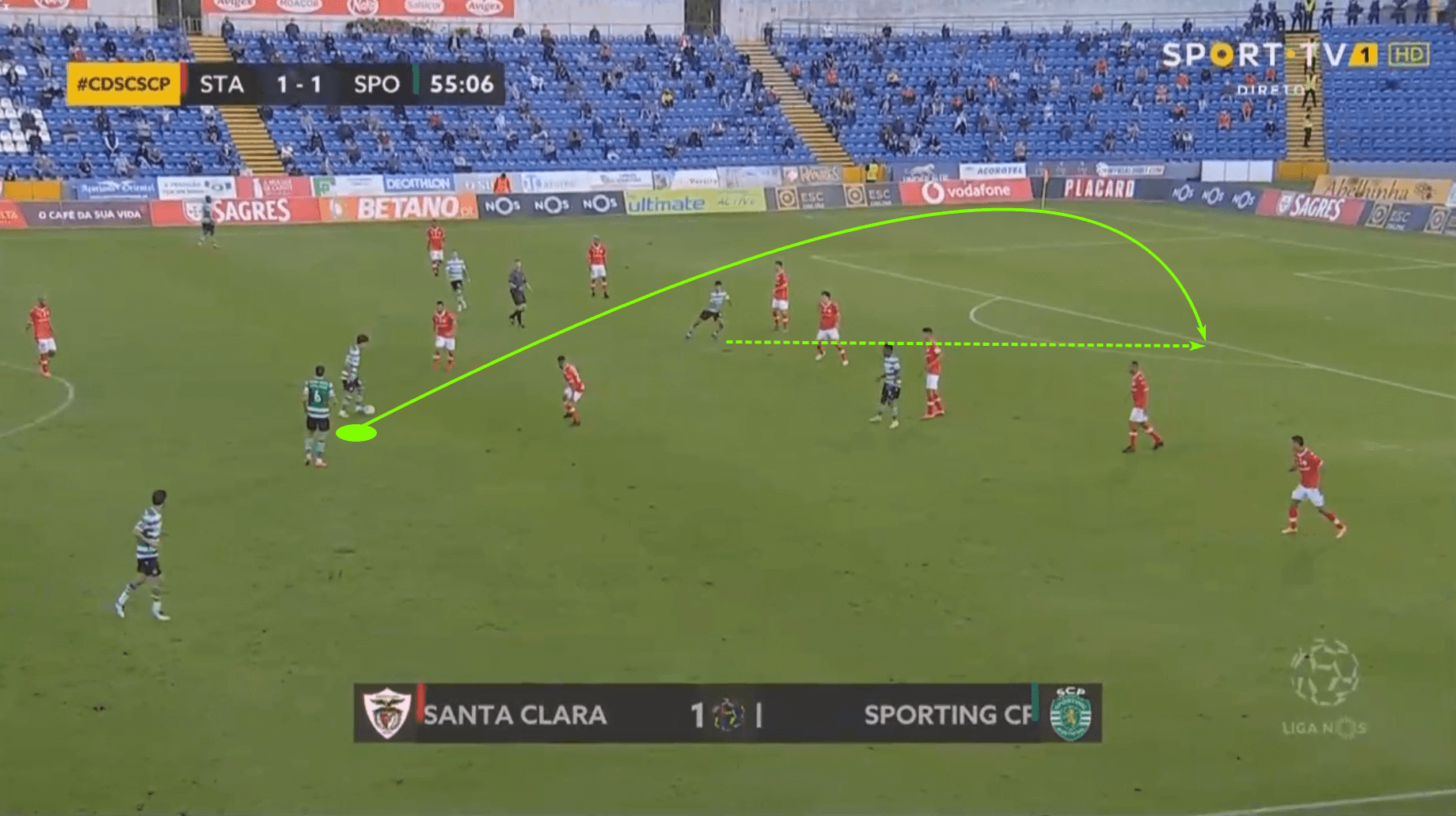
The underlying technical qualities are there, I think it is simply a matter of assessing situations better and matching them to the right technical action. He is only 22, so the next couple of years, especially with Champions League play on the horizon, will give Pote the platform and experience to show his quality.
Conclusion
While he’s not Bruno Fernandes, Pedro Gonçalves has come into the Sporting side and given them the goalscoring spark they desperately needed. When Fernandes left, there was a massive void at the club. Pote has stepped into that role and has the Lisbon club in a countdown to their first league title in 19 years.
Pote’s a unique player, one who excels with freedom. Not only does he put himself in quality positions to contribute, but he uses the freedom afforded by Amorim’s tactics to make his teammates better as well. That will be something for him to keep in mind as he looks to his future.
For now, and hopefully for at least a couple of years to come, he’s the man at Sporting Portugal. He and Amorim have rejuvenated this side, filling the void in leadership and goal production. If the club can claim their first title in 19 years these two will step into the global spotlight and get a chance to show their wares in the UEFA Champions League. The countdown is on.

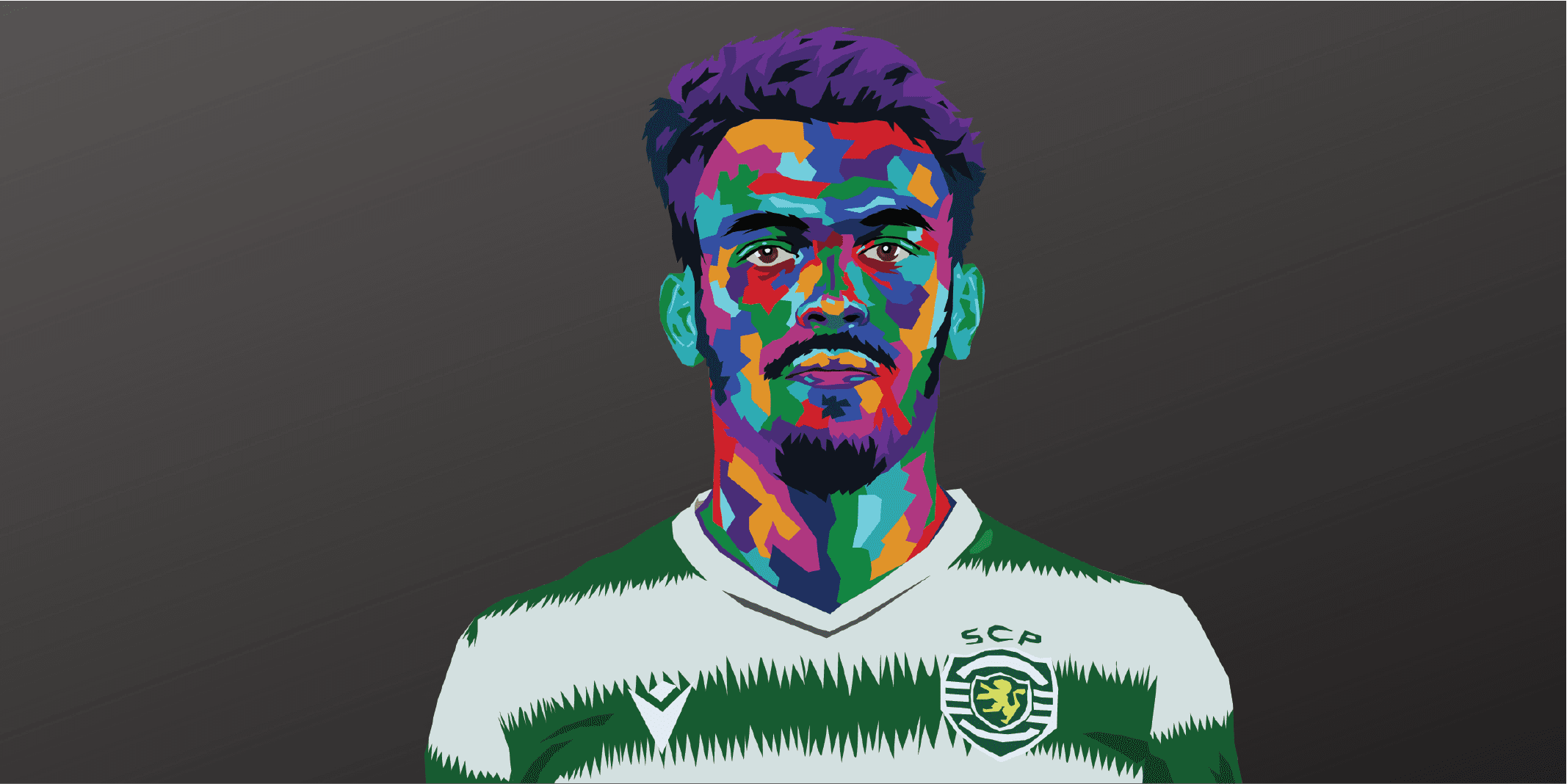



Comments